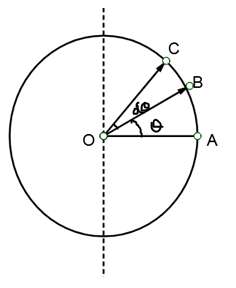
Moment of inertia of a hollow sphere of mass M and diameter D about its diameter
A.)
B.)
C.)
D.)
Answer
509.7k+ views
Hint: The moment of inertia of a point object about any axis is equal to the product of its mass and the square of the perpendicular distance between object and axis. To calculate the moment of inertia of any continuous mass system we break down the object into point mass and add moment of inertia of all point masses to get the moment of inertia of the entire system. We can also break the continuous mass system into a system of already known moments of inertia. (for e.g. breaking discs into rings, etc.)
Complete step by step answer:
To calculate the moment of inertia of a hollow sphere we will divide the sphere into thin rings. In order to do so we will go to angle

Now, our aim will be to first calculate the moment of inertia of this ring.
We can clearly observe that every point of this ring is situated at an equal distance from the axis, which is equal to the radius of the ring. From simple trigonometry we can find the radius is
Surface mass density of the sphere will be its total mass divided by its total area i.e.
So mass of ring will be
Now moment of inertia of ring will be product its mass and square of its radius i.e.
This is the moment of inertia of a ring at an angle
So moment of inertia of hollow sphere is
=
=
On integration we will get
Hence the correct option is C.
Note:
Complete step by step answer:
To calculate the moment of inertia of a hollow sphere we will divide the sphere into thin rings. In order to do so we will go to angle

Now, our aim will be to first calculate the moment of inertia of this ring.
We can clearly observe that every point of this ring is situated at an equal distance from the axis, which is equal to the radius of the ring. From simple trigonometry we can find the radius is
Surface mass density of the sphere will be its total mass divided by its total area i.e.
So mass of ring will be
Now moment of inertia of ring will be product its mass and square of its radius i.e.
This is the moment of inertia of a ring at an angle
So moment of inertia of hollow sphere is
=
=
On integration we will get
Hence the correct option is C.
Note:
Recently Updated Pages
Master Class 9 General Knowledge: Engaging Questions & Answers for Success

Master Class 9 English: Engaging Questions & Answers for Success

Master Class 9 Science: Engaging Questions & Answers for Success

Master Class 9 Social Science: Engaging Questions & Answers for Success

Master Class 9 Maths: Engaging Questions & Answers for Success

Class 9 Question and Answer - Your Ultimate Solutions Guide

Trending doubts
State and prove Bernoullis theorem class 11 physics CBSE

Who built the Grand Trunk Road AChandragupta Maurya class 11 social science CBSE

1 ton equals to A 100 kg B 1000 kg C 10 kg D 10000 class 11 physics CBSE

State the laws of reflection of light

One Metric ton is equal to kg A 10000 B 1000 C 100 class 11 physics CBSE

Difference Between Prokaryotic Cells and Eukaryotic Cells




